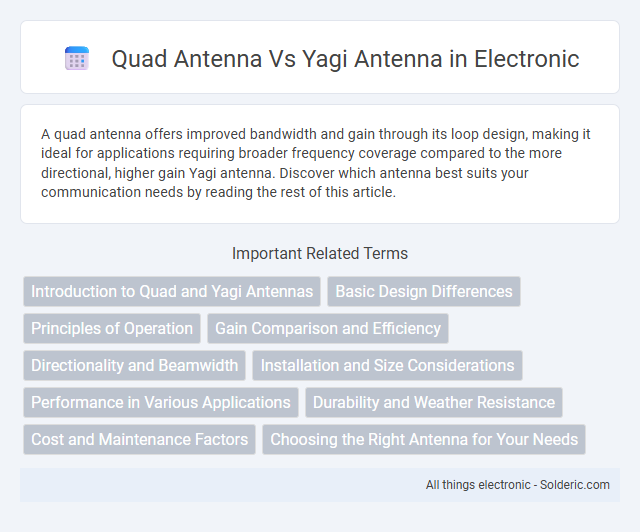A quad antenna offers improved bandwidth and gain through its loop design, making it ideal for applications requiring broader frequency coverage compared to the more directional, higher gain Yagi antenna. Discover which antenna best suits your communication needs by reading the rest of this article.
Comparison Table
| Feature | Quad Antenna | Yagi Antenna |
|---|---|---|
| Design | Square loop elements | Linear dipole and directors |
| Gain | Moderate gain (7-9 dBi) | Higher gain (8-12 dBi) |
| Bandwidth | Broader bandwidth | Narrower bandwidth |
| Directionality | Directional with moderate front-to-back ratio | Highly directional with high front-to-back ratio |
| Size | Larger and bulkier | Compact and lighter |
| Polarization | Linear polarization | Linear polarization |
| Applications | Ham radio, VHF/UHF communication | TV reception, ham radio, point-to-point links |
| Construction Complexity | More complex to build | Simple to build |
Introduction to Quad and Yagi Antennas
Quad antennas feature a square loop design that offers high gain and a broad bandwidth, making them suitable for amateur radio and VHF/UHF applications. Yagi antennas consist of a driven element, reflector, and multiple directors aligned linearly, providing focused directional gain ideal for long-distance communication. Both antenna types are widely utilized for their efficiency in enhancing signal strength and minimizing interference in various radio frequency bands.
Basic Design Differences
A quad antenna features a square loop element design, which provides higher gain and better bandwidth compared to the Yagi antenna's linear dipole elements. The Yagi antenna consists of a driven element, reflector, and multiple directors arranged in a straight line to focus radio waves in one direction. Your choice depends on the application, as quad antennas offer better signal reception in multipath environments, while Yagi antennas excel in long-distance directional communication.
Principles of Operation
A quad antenna operates on the principle of using square loops to achieve higher gain and better bandwidth by creating multiple resonant elements, which enhance signal strength and directivity. In contrast, a Yagi antenna relies on a driven element, reflector, and several directors arranged linearly to focus radio waves in a specific direction, maximizing forward gain while suppressing interference. Understanding these principles helps you choose the appropriate antenna for applications requiring precise signal control and efficiency.
Gain Comparison and Efficiency
A quad antenna typically offers higher gain and better efficiency compared to a Yagi antenna due to its full-wavelength loop elements that reduce radiation losses. The quad design achieves approximately 1 to 2 dB more gain over a Yagi with the same number of elements, enhancing signal strength in directional applications. Efficiency improvements in quad antennas also arise from lower conductor losses and improved impedance matching, resulting in superior overall performance in amateur radio and communication systems.
Directionality and Beamwidth
Quad antennas feature a square loop design that provides higher gain and a narrower beamwidth, resulting in greater directionality compared to Yagi antennas. Yagi antennas use multiple linear elements, typically offering a wider beamwidth but slightly less focused directionality than quad antennas. Your choice between the two should consider the specific need for signal precision and coverage area in your application.
Installation and Size Considerations
Quad antennas generally require more space and a sturdier mounting structure due to their square-loop design, which can make installation more challenging compared to Yagi antennas. Yagi antennas are typically more compact and lighter, simplifying both the mounting process and the need for support, especially in locations with limited space. Your choice depends on available installation area and support infrastructure, with Yagi antennas offering easier handling in constrained environments.
Performance in Various Applications
Quad antennas provide higher gain and improved front-to-back ratio, making them ideal for long-distance communication and applications requiring precise signal directionality. Yagi antennas excel in simpler designs with moderate gain and are preferred for TV reception and local broadcasting due to their narrow bandwidth and cost-effectiveness. Your choice between quad and Yagi antennas should consider specific performance needs such as gain, directionality, and application environment.
Durability and Weather Resistance
Quad antennas typically offer superior durability and weather resistance compared to Yagi antennas due to their closed-loop design, which provides structural integrity and less wind resistance. The rigid aluminum construction used in most quad antennas enhances their ability to withstand harsh weather conditions such as strong winds, rain, and ice. Yagi antennas, with their exposed elements and boom, tend to be more susceptible to damage from environmental stressors, potentially requiring more frequent maintenance and replacement.
Cost and Maintenance Factors
Quad antennas generally have higher manufacturing and installation costs due to their complex structure and multiple elements compared to Yagi antennas, which are simpler and more cost-effective. Maintenance for quad antennas can be more labor-intensive because their wire loops are more susceptible to weather damage and require periodic tension adjustments, while Yagi antennas typically need less frequent servicing due to their rigid, single-element design. The long-term expenses of quad antennas may be offset by their superior gain and directivity, but budget-conscious users often prefer Yagi antennas for their lower upfront and upkeep costs.
Choosing the Right Antenna for Your Needs
Quad antennas offer higher gain and better signal stability in multipath environments compared to Yagi antennas, making them ideal for applications requiring enhanced reception and transmission quality. Yagi antennas are more compact, lighter, and easier to install, suited for directional communication with moderate gain demands such as amateur radio and TV reception. Selecting between quad and Yagi antennas depends on factors like desired gain, installation space, and the specific frequency range being targeted.
quad antenna vs yagi antenna Infographic

 solderic.com
solderic.com